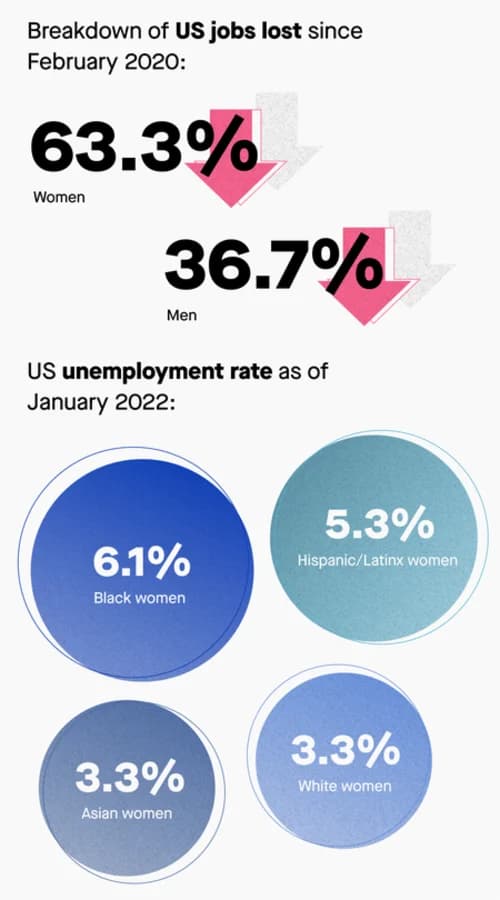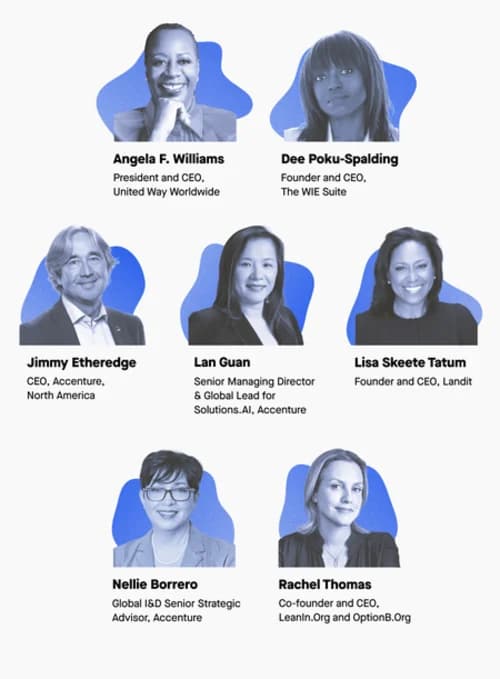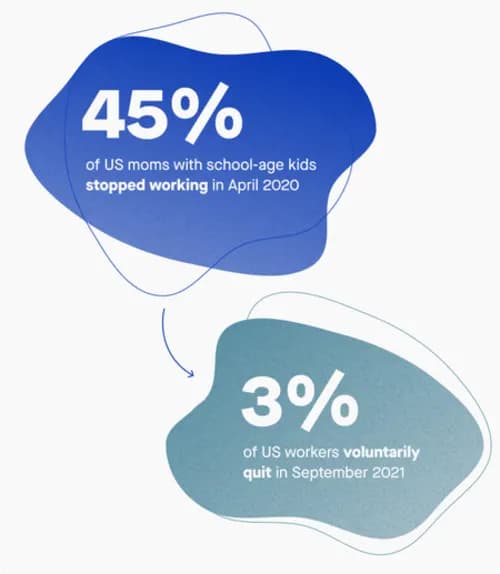Work Isn’t Working for Women. Here’s How to Fix It.
This article was originally published on the Quartz blog by Accenture.
There’s a reason the post-covid labor market has been dubbed a “she-cession.” A February 2022 report from the National Women’s Law Center calculates that women account for 63.3% of US jobs lost since the pandemic began. Two years later, American men’s employment rate has returned to baseline, yet there are more than 1.1 million fewer women in the US labor force compared to early 2020.
Black women have been particularly hard-hit, with an unemployment rate more than twice that of white women. Hispanic/Latinx women have fared slightly better, but they still have a higher unemployment rate than white or Asian women.

SOURCES: NATIONAL WOMEN’S LAW CENTER, 2022, BUREAU OF LABOR STATISTICS, 2022
While the pandemic has had a disproportionate impact on working women, especially women of color and women in frontline industries like healthcare, retail, and education, gender inequality on the job is nothing new. In many ways, covid simply exacerbated long standing problems, but it also opened a gateway of empathy for solving them with urgency.
Breaking down barriers and making workplaces more equal helps women and their families, but it benefits the corporate bottom line, too. According to a 2019 Pipeline report, companies today see a 1-2% revenue increase for every 10% increase in intersectional gender equity.
Companies today see a 1-2% revenue increase for every 10% increase in intersectional gender equity.
Overcoming decades of discrimination and broken systems isn’t easy, but meaningful change is possible, says Accenture’s North America CEO Jimmy Etheredge. “As more leaders commit to equality and to creating a sense of belonging in their businesses, it gives me hope that we are building momentum in a movement, not just a moment. And if we keep pulling together, we’ll push forward to a better place.”
Based on insights from Etheredge and the female business leaders below, here are five ways leaders and managers can make work better for women right now.

Encourage flexibility for all
Some people love working from home. Others can’t wait to return to the office. But according to Accenture’s 2021 Future of Work report, the majority of workers—83%—prefer a hybrid model, but widespread participation in this new way of working is essential.
“We have to be careful that we don’t create a dynamic where women are taking advantage of flexible work and men aren’t,” says Dee Poku-Spalding, founder and CEO of female networking platform The WIE Suite, in a recent episode of Accenture’s Change Conversations podcast. “You could end up with an imbalance where women aren’t in a position to advance their careers because they’re not networking the same way or they’re not accessing opportunities in the same way, because they’re not [in the office] on Fridays.”
Managers can avoid this imbalance by asking all employees to work remotely for part of the week and by scheduling one-to-ones consistently and always via video-call. Team-building activities like lunch and learns, book clubs, and coffee hours can be virtual, too. A 2021 study showed that in-person networking events can, in fact, put women at a disadvantage, whether that’s from time constraints on women with dependent family members or different after-work interests than their male counterparts.
Invite women to be a part of the solution
A 2021 Gallup study revealed troubling statistics about just how increasingly stressed women are these days. Gallup’s 2019 survey found that 30% of women and 27% of men said they “always” or “very often” felt burned out at work. That gender gap quadrupled from March to December 2020 (34% of women and 22% of men) and averaged an eight-point difference in 2021.
And in March 2022 a collaboration of Berlin Cameron, Eve Rodsky’s Fair Play, and Kantar, surveyed more than 1,000 employees and found that 68% of US women experienced burnout in the previous seven days; 50% of US men reported the same.
And in March 2022 a collaboration of Berlin Cameron, Eve Rodsky’s Fair Play, and Kantar, surveyed more than 1,000 employees and found that 68% of US women experienced burnout in the previous seven days; 50% of US men reported the same.
These reports and others uncover a perfect storm of burnout factors, including pandemic-related health concerns and discontent with the division of chores and caregiving at home to fears of being judged for taking advantage of flexible work policies and the emotional labor spent tending to the well-being of colleagues.
In another Change Conversations episode, LeanIn.org CEO Rachel Thomas sums it up like this: “Women aren’t burned out because we’re less resilient,” she says. “Women are burned out because we’re doing more at home, and we’re doing more at work.”
Women aren’t burned out because we’re less resilient. Women are burned out because we’re doing more at home, and we’re doing more at work.
That much burnout takes a toll on women’s mindsets, which in turn affects their outlook on work. Accenture’s 2021 Future of Work study found that fatigue and pessimism go hand-in-hand; because of these negative emotions, 46% of survey respondents described themselves as “disgruntled” or “apathetic.”
Managers can ease the burden by recognizing the value of invisible work and stepping in to reassign tasks as needed to allocate fairly to female and male direct reports. But don’t launch anti-burnout initiatives without first consulting the experts: women themselves. Create space for women to lead honest conversations about their experiences and recognize that there’s no one-size-fits-all solution. Women face different challenges depending on their race, sexual orientation, age, and seniority.
Then let these ideas determine next steps, and commit to engaging everyone, regardless of gender, in taking action. As she put it on the Change Conversations podcast, “I’m concerned when leaders at all levels don’t take into account the need to listen, the need to invite women to the table and let us design what works for us,” says United Way Worldwide CEO Angela F. Williams, “as opposed to saying, ‘This is what we think is appropriate for you.’”
Rethink hiring rules and routes
It’s time to get rid of that old HR benchmark—the seamless history of employment—which penalizes women who take time off for caregiving, personal health issues, or burnout. Post-covid, résumé gaps have become the norm, not the exception, especially among women with kids. In the first months of the pandemic, the US Census Bureau found that 3.5 million US moms stopped working, and by April 2020, 45% of American mothers with school-age children were out of the workforce.
A year and a half later, workers of all genders are stepping back from their jobs due to exhaustion and frustration. The World Economic Forum found that voluntary quitting in the US hit a record high of 3% of the total workforce in September 2021, with the highest resignation rates among mid-career workers.
The Mom Project is making the case for hiring differently—and showing how it can be done. The platform helps people find work on their own terms, providing resources and connections with top companies. It’s paying off: In 2021, Accenture announced that it would hire 150 Mom Project members in tech, strategy, and consulting roles, with an emphasis on people who have been out of the workforce.
Recruiting from networks like The Mom Project, instead of traditional pipelines, requires buy-in from individual managers as well as HR teams, but it’s also a step toward long-term business health. A September 2021 Accenture/Harvard Business School study found that companies that hire “hidden” labor like part-time workers, caregivers, and people with employment breaks are 36% less likely to face talent and skill shortages.
Finding these unconventional paths into the knowledge economy is especially important for women of color, who are more likely than white women to hold lower-paying jobs. These jobs in healthcare, retail, and education may be called “essential work,” yet they are less likely to provide benefits, paid leave, and schedule flexibility. Making the leap to careers with better pay will benefit women and their families, too; according to The Center for American Progress, 67.5% of Black moms and 41.4% of Latinx moms are primary breadwinners, compared to 37% of white moms.

SOURCES: US CENSUS BUREAU, 2021; WORLD ECONOMIC FORUM, 2021
Invest in women of color
Making a statement of support for working women is nice, but reversing inequity requires money and action. The Accenture Black Founders Development program was created to link Black entrepreneurs with capital and mentorship, a direct response to the fact that Black founders—male and female combined—receive about 1% of all VC funding. By leveling the playing field, the program helps Black women build businesses, creating new talent pipelines and job opportunities within their own networks and communities.
In February 2022, the program announced its first investment: SwayBrand, a Los Angeles-based platform that connects companies with multicultural influencers. It’s co-led by Century Williams, who left her corporate job to pursue her passion for media and brand-building. Now, SwayBrand is forging deals with diverse partners like Black Girls Golf, Yanique Holder, and Briona Lamback. “When you invest in people of color, when you invest in women, you are going to get a return that is beyond belief,” Williams says.
In February 2022, the program announced its first investment: SwayBrand, a Los Angeles-based platform that connects companies with multicultural influencers. It’s co-led by Century Williams, who left her corporate job to pursue her passion for media and brand-building. Now, SwayBrand is forging deals with diverse partners like Black Girls Golf, Yanique Holder, and Briona Lamback. “When you invest in people of color, when you invest in women, you are going to get a return that is beyond belief,” Williams says.
When you invest in people of color, when you invest in women, you are going to get a return that is beyond belief.
Businesses can also amplify their investments by collaborating. That’s the idea behind NPower’s Command Shift Coalition, a nationwide consortium that brings women of color into the tech industry. Currently, only 5% of tech workers are Black and Latinx women. Accenture is one of Command Shift’s latest partners, joining a roster that includes Fortune 500 firms as well as nonprofits. By combining resources and expertise, the coalition impacts recruiting, hiring, and pay equity in tech.
It’s important to think past entry-level stages, too. The Hispanic IT Executive Council (HITEC) connects senior business and tech executives looking to advance their careers and mentor new leaders. Nellie Borrero, Global I&D Senior Strategic Advisor at Accenture, joined the HITEC board in 2020, saying: “I’m excited to be part of an organization whose mission is to close the gap of Hispanic representation in leadership roles in the technology industry.”
On a personal level, allyship as a verb, not a mindset, is an essential shift, Thomas explains. “What I see in my research is that 80% of white employees see themselves as allies to women of color,” she says. “But when you start to ask about specific allyship actions, like speaking out when you see discrimination or publicly advocating for racial equity or mentoring a woman of color, the numbers drop like a rock. Only one in 10 white employees say they’ve mentored or sponsored even a single woman of color.”
Provide a path to progress
Legacy inequalities create barriers to professional development, which in turn hinders career growth. In some skill-intensive industries, even getting a foot in the door is daunting: the proportion of women working in tech is 32%, and only 5% of tech workers are Black and Latinx women. Meanwhile, women are over-represented in service, education, and care industries, which often lack opportunities for learning and advancement.
FutureofU: Skills. Job. Growth. is a new platform that represents the next wave of on-demand upskilling, helping women identify opportunities in high-growth areas such as data science and AI. From there, candidates begin role-specific skill training, receiving pay, benefits, and personalized coaching to prepare them for success. Upon completing the FutureofU program, participants are ready to step into their new jobs full-time.
“We’re very proud that Solutions.AI for talent and skilling is powering FutureofU,” says Lan Guan, senior managing director and global lead for this division of Accenture. “It’s helping people who left the workforce due to covid master new skills and find work in a new digital career.”
Giving employees the chance to grow positively impacts promotions and retention, too. “Intake is really important,” says Lisa Skeete Tatum, recent Change Conversations guest and founder and CEO of personalized career-pathing platform Landit, which focuses on increasing the success of women and diverse groups in the workplace.
“But equally if not more important is what happens when someone gets there. Do they stay? Do they thrive? Do they progress?”
This content was originally produced on behalf of Accenture by Quartz Creative and not by the Quartz editorial staff. Sources are provided for informational and reference purposes only. They are not an endorsement of Accenture or Accenture’s products.
Fairygodboss is proud to partner with Accenture. Find a job there today!
Why women love us:
- Daily articles on career topics
- Jobs at companies dedicated to hiring more women
- Advice and support from an authentic community
- Events that help you level up in your career
- Free membership, always
